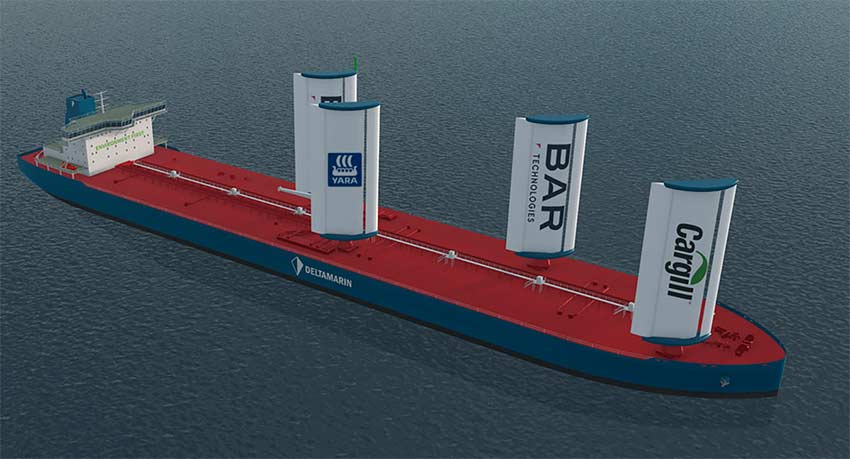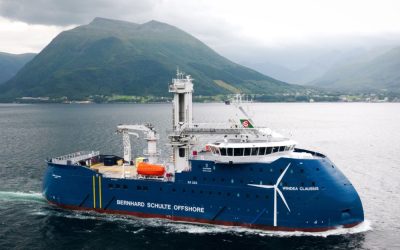Modern wind-assist systems are a major departure from traditional sail systems in that they are not made of canvas and while there may be some systems that can alter their shape, most are made of rigid materials and have automated control systems.
Flettner rotors have been the most popular choice of system so far accounting for around half of all systems installed. Most installations have been carried out by Norsepower and cover several ship types including ferries, tankers and bulk carriers. The largest vessel to feature the Finnish company’s products is Sea Zhoushan a 325,000dwt VLOC owned by Pan Ocean Ship Management and chartered by Vale.
Any structure on the deck of a ship that extends maybe 40m upwards from the deck, has the potential to be a hazard when transiting under bridges or during cargo operations. To enable efficient cargo operations, the five 24m-high and 4m-diameter rotor sails on Sea Zhoushan can be tilted between the cargo hatches by using hydraulic cylinders. Tilting rotors were also installed on the ro-ro SC Connecter in 2021 and are said to be able to give a 25% reduction in emissions and in theory under ideal conditions can allow the vessel to operate on wind assistance alone.
Norsepower’s rivals in the Flettner rotor segment include Anemoi and Eco-Flettner. All have references in operation or planned. Anemoi has a tilting system and an alternative rail-mounted system that allows the rotors to be moved along the ship during cargo operations. The first of this type was installed on the ultramax bulker Afros in 2018. On this ship the movement is longitudinal but other installations planned for the Kamsarmax bulkers Axios and TR Lady will have rotors that are moveable transversally.
Anemoi has some other interesting projects underway including tiltable rotors on bulkers for Berge that will fold across the vessel and a project involving Japanese operator MOL for a wood chip carrier to be built by Oshima that will feature Anemoi’s rotors and a hard sail developed by MOL under the name Wind Challenger. This would be the first ship to incorporate two different wind assist technologies. In August this year, MOL and Anemoi announced that the co-operation would continue with plans for a second vessel that will be delivered in 2024.
MOL’s inhouse Wind Challenger system involves a telescopic hard sail comprising four tiers each around 20m high and 15m wide. The system has been in development for 13 years and should make its debut late in 2022 after the elements for it were completed at the beginning of this year.
After Flettner rotors, the most used technology is currently the suction wing method. Leading proponent of this technology is Netherlands-based Econowind. The system is related to Flettner rotors, but the rotating element is contained inside a ventilated shell that can be rotated to gain the maximum effect. Econwind’s version of this technology goes under the name Ventifoil and has been fitted to a number of Dutch short-sea vessels.
As well as MOL’s Wind Challenger, another hard sail system that is gaining references is that developed by UK-based BAR Technologies and marketed by Yara Marine. The system known as WindWings features hard sails that are comprised of three sections. A larger central section is bounded on each side by a smaller hinged section that can rotate for optimising performance and for storage purposes.
Because the sails when fully extended are wide they have the potential to interfere with line of sight from the ship’s bridge. To compensate for this, the system incorporates cameras that display the required view on the bridge. A first reference for the system was announced in June 2022 and involves Cargill and MC Shipping’s Singapore Branch – the shipping arm of the Mitsubishi Corporation. The chosen vessel is the five-year-old 80,962dwt bulk carrier Pyxis Ocean with installation due to take place in early 2023.
Two WindWings will be delivered by Yara Marine Technologies and installed on the Pyxis Ocean, with one of those wings funded as part of EU Horizon 2020 Project CHEK, dedicated to demonstrating solutions for decarbonising international shipping. BAR has said that a projected reduction in average fuel consumption of up to 30% for a full-scale deployment is anticipated.
Most of the wind-assist systems on offer or under development promise fuel efficiencies in the region of 10-40%. A very few such as the French Neoline project envisage wind being the sole source of routine propulsion requirements. The Neoline ship which is to provide a trans-Atlantic ro-ro service uses a rigid sail system supplied by Chantiers de l’Atlantique and given an AiP by Bureau Veritas.
Neoline only announced the decision to go with a solid sail system in May 2022 after having previously planned a more traditional flexible sail solution. After technical studies carried out by Chantiers de l’Atlantique and others it seems the 136m-long ship’s rigging will consist of a pair of folding rigging systems, including two masts of 76m hight each equipped with the French builder’s solid sail technology covering 1,100m² and a flexible jib of 400m² for a total sail area of 3,000m².
The calculations apparently showed that the rigid sails will provide equivalent or even better performance than the 4,200m² of flexible sails initially planned for the duplex rig, thanks to the thinness and vertical elongation of the structure, as well as the reduction of the masking effect of the sails. The expected lifetime of the sail is 25 years, which will reduce maintenance costs compared to soft sails. The announcement coincided with an announcement that a crowd funding campaign would continue until a further €300,000 had been raised to progress the project.
For the full article please see the November/December edition of The Naval Architect.




